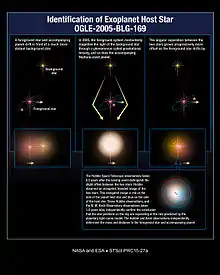OGLE-2005-BLG-169Lb
OGLE-2005-BLG-169Lb is an extrasolar planet located approximately 2700 parsecs away in the constellation of Sagittarius, orbiting the star OGLE-2005-BLG-169L. This planet was discovered by the OGLE project using the gravitational microlensing method. Based on a most likely mass for the host star of 0.49 solar mass (M☉), the planet has a mass of 13 times that of Earth (M⊕). Its mass and estimated temperature are close to those of Uranus. It is speculated that this planet may either be an ice giant like Uranus, or a "naked super-Earth" with a solid icy or rocky surface.[1]
| Discovery | |
|---|---|
| Discovered by | MicroFUN, PLANET/RoboNet, OGLE |
| Discovery date | 10 March 2006 |
| Gravitational microlensing | |
| Orbital characteristics | |
| Star | OGLE-2005-BLG-169L |
| Physical characteristics | |
| Mass | 13 M⊕ |
| Temperature | ~70 |
See also

How a star can magnify and brighten the light of a background star when it passes in front of the distant star.[2]
References
- Gould, A.; et al. (2006). "Microlens OGLE-2005-BLG-169 Implies That Cool Neptune-like Planets Are Common". The Astrophysical Journal Letters. 644 (1): L37–L40. arXiv:astro-ph/0603276. Bibcode:2006ApJ...644L..37G. doi:10.1086/505421.
- "Identifying Planets". Retrieved 3 August 2015.
External links
- "OGLE-05-169L". Exoplanets. Archived from the original on 2010-03-18. Retrieved 2008-08-22.
- "Newfound Ice World Alters Perceptions of Planetary Systems". SPACE.com. Retrieved 2008-08-22.
- "MICROLENSING EVENT OGLE-2005-blg-169". PLANET/RoboNet microlensing campaign. Archived from the original on September 30, 2007. Retrieved 2008-08-22.
This article is issued from Wikipedia. The text is licensed under Creative Commons - Attribution - Sharealike. Additional terms may apply for the media files.